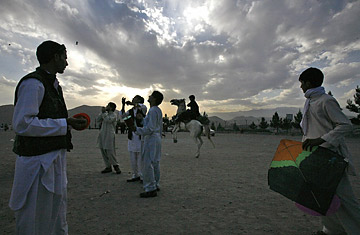
Afghans fly kites and ride a horse on the second holiday of the Eid al-Fitr, in Kabul, Afghanistan.
On a recent Friday when their country's election crisis continued to unfold, a clique well to do Afghans flew kites on dusty Nadir Shah Hill in Kabul. The hill is famous for this — sometimes it is simply called Kite Hill. It is a dusty, rutted place, overlooking the city. "This isn't proper," says Mohammed Ushan, 54, who works at the ministry of construction. "The Municipality of Kabul ought to take better care of this hill." His friend, Aziz Ullah Kukchar, 37, adds that the whole place ought to be developed. "If there was a proper park, and restaurants, and billiards tables, 70% of the people here would not fly kites," he says. "We would charge admission." Kukchar, who says he was in the import-export business and has lived in Moscow, thinks that it would be "good for the park to look like Gorky Park."
These are, of course, difficult times to develop parks, and the idea that Afghans would turn away from their traditions devalues the familiar analogies between kite flying and Afghan politics that became famous in the bestselling novel The Kite Runner. On Kite Hill, as in the book, the kite string is textured in glue and glass, and can slice a sleeve or draw blood from a finger as it un-spools skyward. Once you've got your kite in the air, the aim is to cut down another kite — these battles can draw in dozens of combatants. And usually the kites are so high it is impossible to see whom you are fighting, or who has killed you. When a kite is killed and begins to flutter to earth, gangs of children — the kite runners — estimate, race and fight to acquire the defeated kites.
And so a sky full of fighting kites is symbolic. The multiplicity of explosive Afghan factions, competing interests and networks remain so complex and hazardous that honest students of the country's recent history are eager to point out the limits of their own knowledge. It is all daunting. As John Dempsey, Senior Rule of Law Advisor for the United States Institute of Peace, says, "there are things I still find confusing about this place, and I've been here seven years."
What this suggests about the involvement of foreign governments, often generated and implemented by rotating officials and soldiers much less experienced, goes beyond daunting to disheartening. Especially in light of a realist idea shared widely among internationals and Afghans alike: "Foreign governments aren't here simply because they care about Afghanistan," as Dempsey put it. "They are here also out of their own perceived national interests."
On Kite Hill, Kukchar, the Gorky Park visionary, voiced a similar idea. The problem was the Americans, the Iranians, the Pakistanis — all the foreigners. He takes over the string of one of the kites he has brought. "The string cuts my fingers," he says, preparing to launch, "but I still fly the kite."
As we spoke, a band of children, perhaps bored with the kites for a moment, gathered around the nearby dog cages of the Mine Dog Center, a local landmine clearing NGO, and a more disturbing symbol of day-to-day life in the Afghan capital than kites on the wind. This was strange because Afghan children do not seem generally to like dogs, fearing them, perhaps, as much as the landmines.
There are indeed dangerous wild dogs in Kabul. This is one reason why the dogs serving at the Mine Dog Center are killed by injection when they complete their service at seven or eight years old, rather than freed into a realm of feral creatures and dog-hating locals. Another reason is that the dogs, even if they found homes, could lead likely Afghan owners into danger, even in retirement, because the German Shepherds would continue to search out ordnance. Explains Mohammed Nabi, 48, rangy and black bearded, "the trainers make the dogs acquainted with explosives from the very beginning." They know of nothing else and will continue to do it without prompting.
Nabi, formerly a de-miner and now deputy at the Mine Dog Center, says that he is too busy to fly kites, even though he and his dogs lived in Kabul's premier kite flying spot. And he does not find it at all strange that the de-mining headquarters shares real estate with the kite capital. "Kite flying is like de-mining, except you use your brain more than your hands," he says, striding to chase away a child throwing rocks at his cages. The kid bolted off, back into the kite-running fray.
